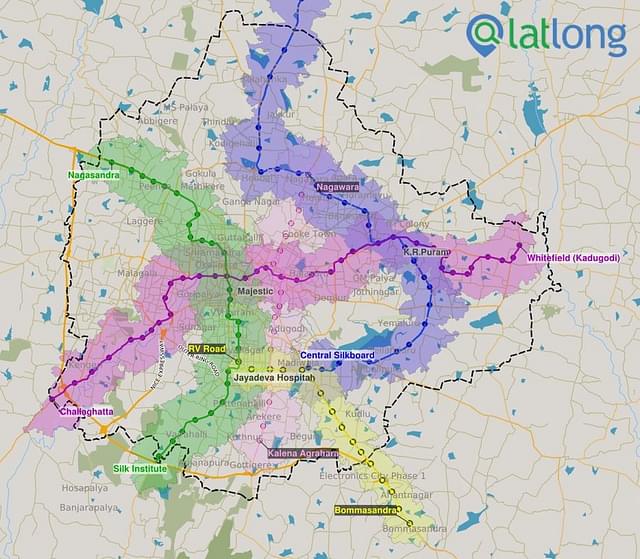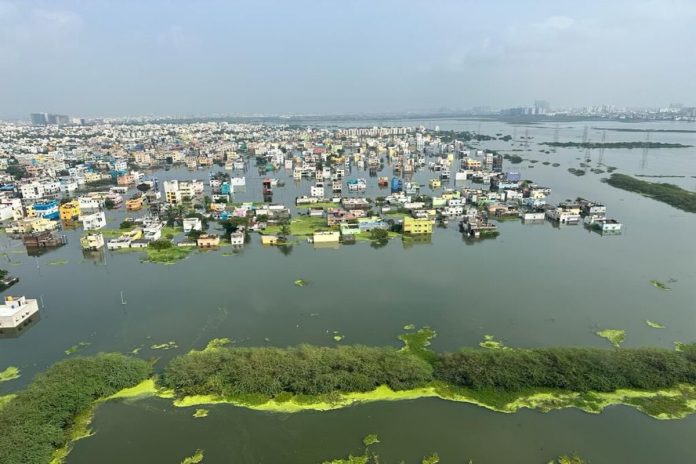The escalating issue of flooding in Indian cities demands a fresh framework of advanced interventions, including geospatial studies, tech driven map-based analysis which can be integrated into new planning and redevelopment initiatives.
Chennai has been the most recent victim, enduring the aftermath of Cyclone Michaung that wreaked havoc through flooding, waterlogged areas, and widespread power outages across the city.
However, it is not just during cyclones. Most Indian cities have become excessively susceptible to even a day’s worth of rainfall, resulting in recurrent urban floods each year.
Cities like Delhi, Bengaluru and Mumbai routinely experience instances where life comes to a halt due to flooding.
Almost at all times, the primary culprits appear to be the unchecked expansion of cities and their infrastructure.
While infra growth is inevitable, with many of our cities are in the midst of expanding and developing newer areas, the pressing need now is for early flood assessments of these regions — to avoid obstruction of surface runoff, negligence in drainage, special focus on construction over channels and in low-lying areas.
The Centre and state governments have been focusing on the layering geospatial data for its infrastructural projects, as part of the Gati Shakti National Masterplan.
Although, there is an equally vital need at regional levels to have superimposed digital databases for the planners, developers and public that can be helpful to mitigate regional challenges such as of urban floods.
How Geospatial Analysis Can Help In Identifying Flood Patterns And Risks
Geospatial analysis in city planning involves using spatial data to strategically decide and design on infrastructure, land use, and can also guide in mitigating risks like floods.
Such analysis plays a crucial role in identifying flood patterns by examining various facets like rainfall, terrain, land cover, infrastructure and density.
By leveraging this approach, it becomes possible to assess risks associated with waterlogging, pinpoint vulnerable areas, and devise effective strategies for managing regions prone to flooding.
Not just planners, but the public and investors can also benefit significantly from this data-driven approach as it offers insights into spatial usage and potential areas for future expansion.
Equipped with this information, stakeholders can make informed decisions regarding the ideal locations for new developments and identify essential services needed based on different neighbourhoods.
However, there is a clear absence of the required platform for producing and circulating such critical information.
Ensuring that all flood-prone areas and developments that can trigger floods are identified, to act on preventive measures, yet remains a challenge.
Private Enterprises Are Using Their Tech For Spatial Analysis
Organisations like Latlong.ai are leveraging their technology for spatial analysis related to infrastructure development in Indian cities.
Operating for the past 15 years, Latlong.ai specialises in providing location-based data. Starting with a navigation system through SMSs, even before the era of smart phones, the company has evolved into offering navigation and location-based data analysis.
Based out of its Bengaluru office, including technical experts, data analysts, engineers — the team harnesses location intelligence to provide marketing insights and unique analytics, and are now also contributing to infrastructure and density analysis in cities.
Speaking to Swarajya, Narayana Bhatta, CEO of Latlong.ai says, “The field of geospatial analysis is very vast. Through our technology and collection of APIs, we are expanding the resources to map infrastructure growth and population analysis around it in cities.”
Their recent mapping analysis focused on the Bengaluru metro network, employing location intelligence to represent the current and future potential of the network.
This representation was overlapped with layers of data — locating the metro corridors, city zones, surrounding land use, and the population density of these areas — to visualise the network’s interactions with city population, new transit services required and economic potential.

Latlong.ai now plans to expand its infrastructure analysis to — the larger road network development underway in India, create an integrated system for the railways to safeguard train network, and also participate in the upcoming opportunities to introduce of the automatic number plate recognition (ANPR) for toll systems.
Technological advancements like these to merge and prepare comprehensive information have the potential to significantly reform the future urban growth.
Using The Same Resources To Counter Challenges Such As Flooding Around Infra Growth In Cities
When considering flood mitigation, these geographical systems play a crucial role by layering vast amounts of information necessary to balance interactions between rainfall patterns, surface runoff, drainage systems, and proposed built environments in upcoming areas.
Meanwhile, organisations such as Latlong, can also independently leverage its tech to create a layer of maps — superimposing the gridlines of the drainage and runoff systems, with the city zonal plans, road networks and proposed built-up.
Converting spreadsheet data of these different parameters into interactive visual representations can offer a clearer analysis to the public, bringing better awareness among potential investors and residents regarding flood vulnerabilities, and opening up more possibilities to counter these.
Meanwhile, the consequences may also include a downside, such as potential reductions in land value and returns for developers and larger investors.
Certain regions may also witness decreased preference or no interests in investments after reading the future vulnerabilities to flooding.
Yet, this transparency will also push developers and planners to prioritise early civic advancements required to mitigate these challenges and proactively focus on its preventions in upcoming regions.


